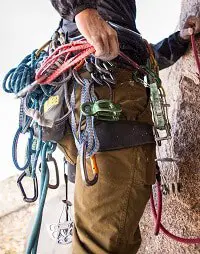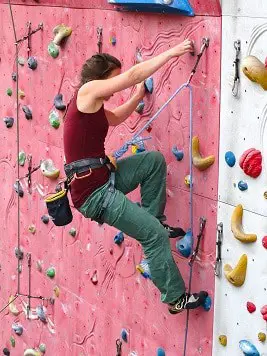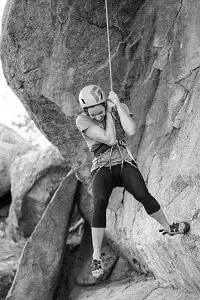Disclosure: Links marked with * are Affiliate Links. As an Amazon Associate, I earn from qualifying purchases if you decide to make a purchase through these links – at no cost for you!
Trad Climbing Basics: Guide for Gear, Techniques & TipsFor the most types of climbing, like rock climbing, you need a rock climbing harness. Harnesses are used for both indoor and outdoor climbing, and choosing the proper one is critical to ensure your safety while you climb.
The harness is often one of the most overlooked pieces of rock climbing equipment. Lots of climbers put a lot of thought into their shoes, cams, carabiners, and even the rope they use for a day on the mountain. However, even though your harness is the only thing keeping you attached to your rope, it is often underappreciated.
There are many things to consider when looking to purchase a new climbing harness, and the perfect harness for you depends on the types of climbing you like to do, your style preferences, the features you want included, and more. In this guide, we’ll tell you everything you need to know about finding a good harness, the different parts of it, how it should fit, and the features it can include.
The Anatomy of a Climbing Harness

Climbing harnesses* are composed of a number of different parts that all serve a specific purpose. It is important to understand the basics of a harness before selecting one so that you know what to look for, how it works, and what everything is used for.
Waist Belt
The waist belt, also known as the Swami belt, can vary significantly between harnesses. This piece can come in different widths, thicknesses, and with different amounts of padding based on the type of climbing it is designed for. Less padded waist belts are often used for sport climbing, while thicker belts are found on harnesses designed for longer climbs, such as multi-pitch or big wall climbs.
Leg Loops
The leg loops are the other part of the harness that provides some padding, and these pieces come in two different styles: fixed and adjustable. Fixed, or non-adjustable, leg loops do not include any buckles on them to change the size. However, they do include some elastic, allowing them to stretch slightly. These harnesses are slightly lighter than adjustable ones and are often great for sport climbing. However, these loops often don’t fit well when you’re wearing multiple layers and are harder to put on over shoes.
On the other hand, adjustable leg loops are a great option for traditional, big wall, or alpine climbing as they can be adjusted to fit over whatever clothing you are wearing. This can also be handy for clothes changes or if you need to put your harness on while you are wearing shoes, ski boots, or other footwear. The adjustability is also useful when adjusting for increases or decreases in leg muscle or weight over time.
The Buckles
Buckles used to be a much bigger talking point than they are today. In the past, the buckle on the waist belt and leg loops were designed in a way that you would have to double back them by feeding the strap back through the buckle. Without doing this, you ran the risk of the buckles loosening or coming completely undone during your climb.
Now, most of the harnesses are designed in a way that the buckles are automatically double backed, preventing the need to do it yourself. However, some harnesses are still designed the old way, so it’s important to know what type of harness you have to ensure your safety while you climb.
Gear Loops
 Gear loops are one of the main features that set harnesses apart from one another. Harnesses often come equipped with between two and 10 of these loops, and they are used to rack your gear while you are climbing. You can attach carabiners, cams, hooks, quickdraws, belay devices, and more.
Gear loops are one of the main features that set harnesses apart from one another. Harnesses often come equipped with between two and 10 of these loops, and they are used to rack your gear while you are climbing. You can attach carabiners, cams, hooks, quickdraws, belay devices, and more.
Some styles of climbing, such as top rope and indoor, don’t require any gear to be carried, so the number of gear loops included isn’t important. However, for other styles, such as lead or multi-pitch climbing, more gear loops are necessary to hold extra gear. For big wall climbing, you’ll want as many loops as you can get because of the longer climb duration.
Belay Loop
 The belay loop runs vertically between the two tie-in loops and is the strongest point on the harness. When you are belaying someone, you attach the locking carabiner and belay device to it. Most harnesses come attached with one of these loops, and it is generally used only for the purpose of belaying.
The belay loop runs vertically between the two tie-in loops and is the strongest point on the harness. When you are belaying someone, you attach the locking carabiner and belay device to it. Most harnesses come attached with one of these loops, and it is generally used only for the purpose of belaying.
As a general rule of thumb, anytime you are attaching a metal device to your harness, it will most likely be through this loop. It is important not to tie anything to this loop as it can wear down faster and become unsafe to use to belay other climbers.
Haul Loop
The haul loop is located on the top of the waist belt at the back, and it is generally made out of either plastic or cord. Its position is often such that it is difficult to access while you are climbing. This makes it ideal to carry items you don’t have much use for, such as a second rope during longer routes, a water bottle, chalk bag, and other items. This loop is not designed to be load bearing, so it shouldn’t be used as an attachment point to support your own weight.
Tie-in Loops
There are two tie-in loops, also known as tie-in points, on each harness: one attached to the waist belt and the other to both of the leg straps. These loops are connected by the belay loop. When you are climbing, the rope is tied through these points.
It is important that you always attach ropes through both points as it helps to distribute the weight evenly. Also, these points are not designed to be used for repelling or belaying because using them instead of the belay loop actually lowers the strength of the carabiner.
Elastic Straps
The elastic straps in the back run from the leg loops to the waist belt. This distance is also known as the rise. Some harnesses do not come with these straps and are known as drop-seat harnesses. Harnesses that do not include rise straps make it possible to detach the leg straps without untying.
For models with these straps, some of them are removable or clip in, allowing them to be removed if necessary. The need for these straps mainly depends on personal preference because it can affect your comfort while hanging.
Clipper Slots
Clipper slots are designed specifically for use during ice climbing. This component is found on the side of the waist belt and consists of one or two slots in the fabric. These slots can be used to attach ice clippers that can hold tools and screws.
While these slots are designed for ice climbing, having a harness with them is not a problem if you don’t ice climb yourself. These slots do not add any extra weight or limit the other functionality of the harness. As an added bonus, if you do want to try ice climbing at some point, you’ll already have a harness that you can use for it.
Choosing the Best Harness Based on Climbing Type
With the exception of bouldering and free soloing, all types of rock climbing require a harness. While most harnesses would likely work for the majority of types of climbing, each harness is designed slightly differently. Some harnesses are designed with specific features that make them more ideal for a specific type of climbing, so you should think carefully about the types of climbing you are primarily interested in and choose a model based on that. Here is a list of the most common types of climbing and the things that you should look for in a harness for that style.
Gym and Sport Climbing
 When you are climbing in a gym or are on sport routes, fixed bolts are often installed on the problems already, eliminating the need to carry extra gear on your harness. The same goes for top-rope climbing as you are being belayed and do not need to clip in along the route.
When you are climbing in a gym or are on sport routes, fixed bolts are often installed on the problems already, eliminating the need to carry extra gear on your harness. The same goes for top-rope climbing as you are being belayed and do not need to clip in along the route.
For these types of climbing, comfort and security are the most important factors when selecting a harness. When you are in a gym or climbing sport routes, a minimal harness is all you need. This means that the number of gear loops is not very important. Also, non-adjustable leg loops are ideal for these types of climbing as these harnesses are lighter and less bulky.
Traditional Climbing

Traditional, or trad, climbing involves placing cams or other protection in the rock as you climb so that it can catch you if you fall. This type of climbing is often done a little closer to the ground, so carrying large numbers of cams, draws, and other gear is not needed like in multi-pitch climbs.
When selecting a harness designed for trad climbing, it is important that you find one with at least four gear loops to provide plenty of space for extra attachments. Adjustable leg loops can also be helpful to allow for varying levels of clothing and quick adjustments throughout the day. Extra padding on the leg and waist straps can be beneficial to make longer days more comfortable, whether you are belaying, climbing, or just hanging out.
–> Trad Climbing Basics: Guide for Gear, Techniques & Tips
Multi-Pitch Climbing
Multi-pitch climbing involves longer climbs, and it is important to select a harness that can hold all of the gear you need. For these routes, you’ll need to be able to carry an entire gear rack in addition to a jacket, a belay device, extra ropes, extra carabiners, and more. These climbs are often much longer, making plenty of comfort and support a high priority.
When selecting a harness for multi-pitch climbing, you’ll want to be sure that you have adjustable leg loops in case you need extra layers and plenty of padding on the waist and leg loops for hip stability and comfort during long days. Having at least four gear loops is also important to ensure you have enough space for all of your gear. In addition, a haul loop is needed for carrying extra rope.
Big Wall Climbing
 If you plan to do any big wall climbing, like routes found in Zion or Yosemite, you should probably invest in a harness designed specifically for that type of climb. These harnesses are designed to be worn for long periods of time, which is perfect for climbs that can take multiple days. These harnesses have really wide straps and lots of padding for long hangs.
If you plan to do any big wall climbing, like routes found in Zion or Yosemite, you should probably invest in a harness designed specifically for that type of climb. These harnesses are designed to be worn for long periods of time, which is perfect for climbs that can take multiple days. These harnesses have really wide straps and lots of padding for long hangs.
Adjustable leg straps are definitely critical as you will most likely need to change clothes to add layers. It’s also important that you find one that is adjustable to be tighter than your usual size. Throughout climbs, you may need to continue to tighten the harness, and having a harness that is too loose is far from ideal. As far as gear is concerned, these harnesses often have between six and 10 gear loops to provide all the storage space you need.
Competition Climbing
Competition climbing involves climbing as fast as you can and being as agile as possible. Because of this, harnesses designed for competition use do not incorporate gear loops as you do not need to carry anything during your climb. These harnesses also generally use skinny belay loops or this piece can be removed all together to eliminate bulk. These are about as simple as it gets when it comes to design to ensure that wearing it does not impede your climb.
How Should a Rock Climbing Harness Fit?
Waist Size
You can wear your climbing harness around your hips or on your waist, depending on what is most comfortable. Generally, if you have wide hips, it will be more comfortable to wear around your waist. However, if your waist and hips are similar in size, having your harness sit around your hips will probably be best.
Be sure to tighten the waist belt so that you are only able to slip a few fingers into the belt. If it is looser than this, it can ride up while you are hanging or belaying. On the other hand, if the waist belt is too tight, it will be uncomfortable and may inhibit your movement.
Leg Size
As we mentioned above, there are both adjustable and fixed leg loops. Adjustable leg straps provide a much larger range of sizes, helping to ensure the proper fit for most anyone. However, fixed leg loops are much lighter, making them ideal for many climbers. These products are only able to vary in size by a few inches though, and each company produces harnesses that are slightly different than one another. Because of this, it is important to measure your leg size to ensure the correct fit.
Rise
The rise, or the distance between the leg straps and waist belt, is critical in order to get the most out of your rock climbing harness. If the rise of your harness does not fit your body correctly, it can cause issues while you are hanging off the rock or wall. If the rise is not long enough and your leg straps are too close to your waist belt, it can cause you to be tilted backwards while you are in the air. This can make it very uncomfortable and difficult to right yourself to continue climbing.
On the other hand, if the rise is too long and your leg loops are too low on your legs, you will be forcing your hips to absorb a majority of your falls, which can be very painful. It is important to make sure that a harness fits properly so that you are kept in a well-balanced and upright position after a fall or when you are resting and hanging. Sitting upright while hanging should feel natural in a properly-fitting harness and you shouldn’t have to fight it.
Adjustability
Having a harness that fits you well is important, but it is also important that it is adjustable beyond that as well. If you are planning to climb with extra layers on, it is critical that your harness is able to loosen up to accommodate this. It is also helpful to have adjustable straps if you constantly need to put your harness on over ski boots or hiking boots.
On the contrary, you may need to tighten up your harness during a long climb or if your bodyweight changes over time to ensure that it still fits snugly to your body. After finding the correct fit, having some room to loosen or tighten your harness provides flexibility to be sure that your harness continues to work throughout its lifetime.
Comfort and Weight
Choosing a harness with the adequate amount of padding largely depends on the types of climbing you will be doing. If you prefer a little extra padding and don’t mind a slightly larger and heavier harness, you should take that into account. Comfort is a huge part of a climbing harness because, even if it has all the features you are looking for, if it is not comfortable to wear, you won’t enjoy it.
It is important to find a balance between the features you need and the level of comfort you desire. Although the more padded models are generally slightly bulkier, heavier, and may cause some restriction of movement, there is always a trade off because being uncomfortable while you are climbing, standing, or belaying others can have a negative effect on your performance and experience.
Harness Designs for Women and Children
Women
 It is important to select a harness that is designed specifically for your gender. Women’s rock climbing harnesses* have three notable differences when compared to men’s harnesses. The first of these is the shape of the waist belt. Women generally tend to wear their harnesses up around their waists as opposed to over their hips. Because of this, the waist belt on women’s harnesses is designed slightly differently.
It is important to select a harness that is designed specifically for your gender. Women’s rock climbing harnesses* have three notable differences when compared to men’s harnesses. The first of these is the shape of the waist belt. Women generally tend to wear their harnesses up around their waists as opposed to over their hips. Because of this, the waist belt on women’s harnesses is designed slightly differently.
Women’s harnesses also differ from men’s in rise height. As we mentioned earlier, the rise is the distance between the leg straps and the waist belt. For men, the rise is generally fairly standard; however, the proper size for women can vary significantly. Women often require a longer rise, which is partially due to wearing the harness around the waist.
The third main modification is due to a difference in hip to waist ratio. Compared to men, women generally have wider hips compared to their waist size. Harnesses are designed to work with this by altering the sizes of the leg loops and waist belt.
Children

Rock climbing harnesses for children* are built with the same basic design as those for adults, but there a number of other features that work specifically with a child’s body type. For older children, age five and up, sit harnesses are often used. These use the same design as adult harnesses and are built to the same standards. These are helpful for older children as it keeps the rope out of their face while they climb and teaches them how to climb safely.
Younger children, below the age of five and under 80 pounds, often have a higher center of gravity when compared to adults or older children. Because of this, it is much easier for them to fall sideways while climbing. For these climbers, a full body, also known as a type B, harness is best. These harnesses include leg straps and a waist belt, but they also incorporate over the shoulder straps for extra security.
Lifespan of a climbing harness
On average, a good harness can be used for about 6 years in normal use. This depends of course strongly on how often you use it, how much you load it and how rough you handle it.
In order to assess the condition of the harness, it should be checked regularly for damage or other signs of wear. With most harnesses, the seams are sewn with threads of a different color than the background. This makes it easier to analyze the seams for defects.
Keep dirt and water away from it and store it in a dark and dry place. If you are unsure if the belt is still secure, you should replace it!
–> When to Retire Climbing Gear
Conclusion
Having the correct harness can help rock climbing to be much more enjoyable. Climbing harnesses have a number of different parts, and there are plenty of features that may appeal to different climbers. It is important to choose a harness based on what style of climbing you like best and what your personal preferences are.
Rock climbing harnesses come in a variety of sizes, with varying numbers of gear loops, with different adjustability options, and much more. The harness is often one of the most overlooked pieces of climbing equipment, but it could be argued that it is one of the most important. Be sure to take into consideration all of your climbing wants and needs before selecting a harness.
Attention: You have to take care of your safety when climbing! The information on climbtheearth.com only helps you to learn. Before you climb, you should make sure that you have been properly instructed by an expert and that you follow all safety precautions.
Disclosure: This website is the property of Martin Lütkemeyer and is operated by Martin Lütkemeyer. Martin Lütkemeyer is a member of the Amazon Services LLC Affiliate Program, an affiliate advertising program designed to enable Web sites to earn advertising revenue through advertising and linking to Amazon.com. Links marked with * are affiliate links.
